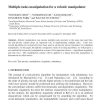Free Online Productivity Tools
i2Speak
i2Symbol
i2OCR
iTex2Img
iWeb2Print
iWeb2Shot
i2Type
iPdf2Split
iPdf2Merge
i2Bopomofo
i2Arabic
i2Style
i2Image
i2PDF
iLatex2Rtf
Sci2ools
AR
2004
2004
Multiple tasks manipulation for a robotic manipulator
Robotic manipulators can execute multiple tasks precisely at the same time and, thus, the task-priority scheme plays an important role in implementing multiple tasks. Until now, several algorithms for task-priority have been used in solving the inverse kinematics for redundant manipulators. In this paper, through the comparative study of existing algorithms, we will propose a new method for task-priority manipulation in terms of two important criteria -- algorithmic singularity and task error. This manipulation scheme will be applied to a planar three-link manipulator to demonstrate its effectiveness.
| Added | 16 Dec 2010 |
| Updated | 16 Dec 2010 |
| Type | Journal |
| Year | 2004 |
| Where | AR |
| Authors | Youngjin Choi, Yonghwan Oh, Sang-Rok Oh, Jonghoon Park, Wan Kyun Chung |
Comments (0)

